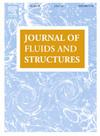Dynamics of a long flexible filament conveyed in the near field of a turbulent jet
IF 3.4
2区 工程技术
Q1 ENGINEERING, MECHANICAL
引用次数: 0
Abstract
This study numerically investigates the conveyance of a long flexible filament in the near field of a jet flow using the immersed boundary-lattice Boltzmann method (IB-LBM) and large eddy simulations (LES). The filament is introduced into the jet flow field from an external domain, delivered by a turbulent jet at a Reynolds number of 4500. This research analyzes the filament's dynamics and morphological evolutions, highlighting the effects of bending stiffness (Kb*), linear density (mf*), and initial velocity (U0*) on conveyance stability. Initially, the filament exhibits stable forward motion with minimal fluctuations in the jet's potential core region. However, as the filament's leading section enters the developing region, a bulging shape forms in the middle section, leading to instability and morphological fluctuations. Increasing mf* and U0* enhance conveyance stability by delaying the bulging formation in the middle section and reducing morphological fluctuations. The leading section of the filament experiences the most significant fluctuations, suggesting that inertia effects dominate upstream. Varying Kb* primary affects the filament's behavior post-instability while does not significantly impact the position of instability onset. Additionally, when U0* is less than half of the inlet airflow speed, the morphological fluctuations are significantly amplified. To improve conveyance stability for long filaments under similar conditions, it is recommended to accelerate the filament to at least half of the inlet jet velocity. These findings provide insights into optimizing long filament conveyance in industrial processes and biomedical applications, where precise control of filament behavior is crucial.
在湍流射流近场中输送的柔性长丝的动力学
本文采用浸入式边界格玻尔兹曼方法(iblbm)和大涡模拟(LES)对射流近场中柔性长丝的输运进行了数值研究。细丝由雷诺数为4500的湍流射流从外部域引入射流场。本研究分析了长丝的动力学和形态演变,重点研究了弯曲刚度(Kb*)、线密度(mf*)和初速度(U0*)对输送稳定性的影响。最初,细丝表现出稳定的向前运动,在射流的潜在核心区域波动最小。然而,当长丝的前导段进入发育区域时,在中间段形成凸起的形状,导致不稳定和形态波动。增大mf*和U0*可以延缓中段隆起地层,减小形态波动,增强输运稳定性。灯丝的前段经历了最显著的波动,表明惯性效应在上游占主导地位。Kb*的变化主要影响纤维失稳后的行为,而对失稳开始的位置没有显著影响。另外,当U0*小于入口气流速度的一半时,形态波动被显著放大。在类似条件下,为了提高长丝的输送稳定性,建议将长丝加速到至少入口射流速度的一半。这些发现为优化工业过程和生物医学应用中的长丝输送提供了见解,在这些应用中,精确控制长丝的行为至关重要。
本文章由计算机程序翻译,如有差异,请以英文原文为准。
求助全文
约1分钟内获得全文
求助全文
来源期刊

Journal of Fluids and Structures
工程技术-工程:机械
CiteScore
6.90
自引率
8.30%
发文量
173
审稿时长
65 days
期刊介绍:
The Journal of Fluids and Structures serves as a focal point and a forum for the exchange of ideas, for the many kinds of specialists and practitioners concerned with fluid–structure interactions and the dynamics of systems related thereto, in any field. One of its aims is to foster the cross–fertilization of ideas, methods and techniques in the various disciplines involved.
The journal publishes papers that present original and significant contributions on all aspects of the mechanical interactions between fluids and solids, regardless of scale.
 求助内容:
求助内容: 应助结果提醒方式:
应助结果提醒方式:


